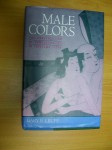12 May 2007
Learning Japan's hidden history by American scholar
Male Colors: The construction of homosexuality in Tokugawa Japan
by Gary P. Leupp, Professor of Japanese History at Tufts University, USA,
I happenned to buy this book almost ten years ago in America.

Before reading this book, I had thought it unlikely that there was any homosexuality in Japan . I also took a negative view of homosexuality, seeing it as a result of the decadence of Western culture. When I came across this book, while in the USA , I was therefore astonished to learn about an aspect of Japanese history about which I, a Japanese, knew nothing.
The book is primarily concerned with male homosexuality in Japan during the Edo Era. However, the Introduction also mentions nanshoku (literally, “male colors”), as the practices of homosexuality and pederasty were then known, as it was prevalent at earlier times. It is said that Kūkai a monk who introduced Buddhism to Japan from China brought the practice of nanshoku, and it was at first mainly among monks that the practice spread. However, during the Age of Warring States (16th century), nanshoku became extremely common among men of the samurai caste. Historical records show that famous samurai lords such as Oda Nobunaga and Takeda Shingen, for example, had sexual relations with their retainers, and there still exist documents showing that Takeda Shingen and his vassal Kosaka Masanobu wrote pledges of sexual love to each other.
After the years of war and chaos, the Edo Era (1603-1867) began with the Tokugawa Shogunate establishing its rule over Japan . However, the Nanshoku Culture continued, and records show that 7 of the 15 Tokugawa shoguns engaged in homosexual activities. Homosexuality was not restricted to the samurai, but was prevalent among the ordinary townsfolk as well. At that time, nanshoku was classified as two main types. In the first type, a couple of men with a marked age difference were seen as having a relationship modeled after older and younger brothers. The second type, on the other hand, was influenced by the male-chauvinist perspective of contempt for women, and one partner took the female role, enabling two men to imitate a heterosexual relationship without having to lower themselves to sexual contact with impure females.
Ihara Saikaku famous novelist in that era, wrote Kōshoku Ichidai Otoko (The Life of an Amorous Man) which is representative of the practice of nanshoku among the common people. The principal character, Yonosuke, the son of a rich merchant, has sexual intercourse with 3,275 women and 725 men during the course of his life. That is a ratio of 5:1, but it probably reflects the general male sexual orientation at the time. To summarize, homosexuality was not a minority concern in society during that era, and the typical male sexual orientation was what would now be termed “bisexual”.
The above information raises the question of why Japan changed so drastically to a society in which homosexuality is regarded with loathing. Leupp indicates the process of modernization during and after late 19th century known as Meiji Era as the cause of this. After Japan opened up to the rest of the world, many Westerners visited Japan and transmitted aspects of Western culture, one of which was severe criticism of the Japanese nanshoku Culture. The ruling and influential classes at that time had great concern about such hostility, and started to insist that nanshoku was morally wrong, in order to bring Japan into line with the Western system of values.
However, a great change can now be seen to have taken place in Western society. In Europe, the USA, and some other countries, the Gay Liberation Movement has been successful in recent years, and in some European countries and some US states even homosexual marriage is now accepted. In other words, Westerners, who introduced loathing of homosexuality to Japan , as part of “modern culture”, have now reconsidered their own value systems. These are certainly curious times in which we live!
Leupp also points out that, in terms of the main currents of society, nanshoku in pre-modern Japan offers a good historic example for discussion about homosexuality. Homosexuals are now generally considered to be a minority of the population, making up 2% to 5%, or perhaps 10%, of the total. However, at least with respect to Japan during the Edo Era, it is difficult to see this as being the case. At that time, Japanese men seem generally to have been bisexual. To conclude, this book suggests that human sexuality is neither innate nor created by a particular family environment, but is a product of the wider society.
It is not just a history of Japan but whole humanity, isn't it?
22:20 Posted in Books | Permalink | Comments (0) | Tags: gay, japan, homosexuality, history
23 May 2006
What is "The Crysanthemum and the sword?"
| A Classic Analysis of the Japanese People - The Crysanthemum and the Sword | |
| | |
| The Crysanthemum and the Sword is a comparative analysis written by cultural anthropologist Ruth Benedict during the Second World War. |
21:25 Posted in Books, Culture | Permalink | Comments (0) | Tags: Japanese





